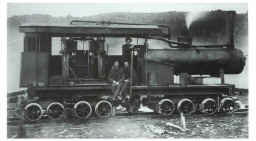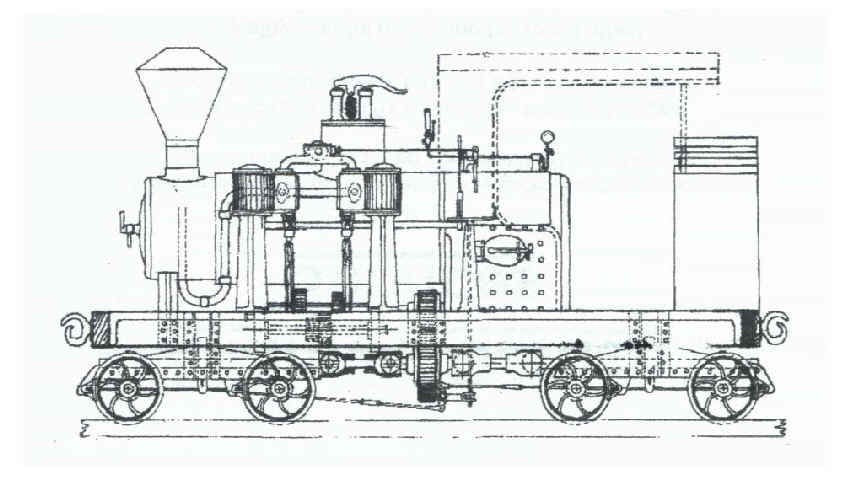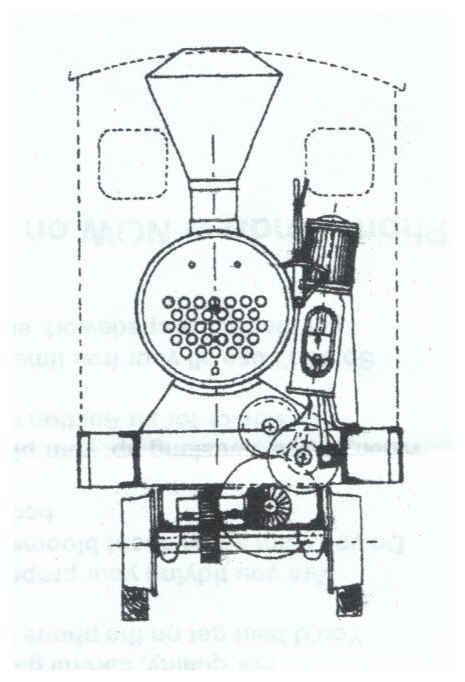
Johnston & Sons built two main designs of bush
locomotives, the small four-wheeler Type A and the much larger 16-wheeler Type D.
Together with one Type B 8-wheeler, Johnston’s built at least 26 steam locomotives
between 1896 and 1930. They originated the concept of the 16-wheeler to replace horse
teams on lightweight track. Johnston’s also built steam log haulers, boilers, steam
winches and other sawmill machinery.
1896 0-4-0 T Type A
A Marlborough Timber Co. Johnston A working around 1910 in the Pelorus Sound area. Note the
jackshaft and connecting rods. (Marlborough Historical Society)
Dimensions not available
J. Johnston & Sons Ltd. built eight of these lokeys
starting in 1896 with the last built in 1927. They were 4-wheelers of about 7 tonnes weight.
cylinder horizontal engine was mounted between the frames under the smoke box from where
it drove a crankshaft near the middle of the loco, thence through herringbone gears onto
a central jackshaft below. This gear ratio was 13:30. The jackshaft, located midway
between the two sets of driving wheels, then drove through side rods to the wheels.
The loco usually towed a 4-wheel tender holding water and fuel but at least four engines
operated as tank locos. More & Sons converted their Johnston ‘A’s to 0-6-0 arrangement fitting a pair of
flangeless wheels to the jackshaft thereby increasing adhesion. The average service life of these
types was about 37 years. One is now on static display at Riverton, near Invercargill and
another resides at McLeans Island.
Click for images of More & Sons Johnston 'A's. ( Courtesy of Jim More )
1910 Type D 16-Wheeler
The above image clearly shows the location of the twin cylinders and the reduction gears
to the drive train. The loco worked at the Glenham Sawmilling Co. in 1910. (Southland Museum)
Dimensions not available. Designed as a replacement for horse teams, the axle
loading of 1 tonne per axle was arrived at as being similar to that achieved on log buggies.
The loco weighed in at 16.25 tons. A twin-cylinder vertical marine type engine was cab
mounted and drove a longitudinal crankshaft that in turn drove an intermediate shaft
via spur gears giving two speeds of ratios 1:1 and 1:2. The intermediate shaft then
drove another set of spur gears down to the level of the line shaft. The lower, larger
gear was 3’6” (1067 mm) in diameter. The line shaft was set just above the truck axles
and a bevel gear pair drove from the line shaft to a stub shaft aligned across the truck.
A pair of spur gears then transmitted power down to the axle. In all a total of 38 gears
were in the transmission. The use of bevels on the stub shaft gave rise to high tooth
stress and rapid wear. The wheels were carried on four trucks, the front two trucks being
joined by a beam pivoted on the trucks and again at its mid-point where it was attached
to the loco frame. The rear trucks were arranged the same. Top speed was about 5 mph
(8km/h) and the average service life about 23 years. None exist today.
Designed as a replacement for horse teams, the axle
loading of 1 tonne per axle was arrived at as being similar to that achieved on log buggies.
The loco weighed in at 16.25 tons. A twin-cylinder vertical marine type engine was cab
mounted and drove a longitudinal crankshaft that in turn drove an intermediate shaft
via spur gears giving two speeds of ratios 1:1 and 1:2. The intermediate shaft then
drove another set of spur gears down to the level of the line shaft. The lower, larger
gear was 3’6” (1067 mm) in diameter. The line shaft was set just above the truck axles
and a bevel gear pair drove from the line shaft to a stub shaft aligned across the truck.
A pair of spur gears then transmitted power down to the axle. In all a total of 38 gears
were in the transmission. The use of bevels on the stub shaft gave rise to high tooth
stress and rapid wear. The wheels were carried on four trucks, the front two trucks being
joined by a beam pivoted on the trucks and again at its mid-point where it was attached
to the loco frame. The rear trucks were arranged the same. Top speed was about 5 mph
(8km/h) and the average service life about 23 years. None exist today.
Only two Type B locos were built (and at least one model) giving a similar
lokey to the Type D but for use on heavier steel rail. The boiler was offset on the
frame, in a similar fashion to the Shay, to allow the two-cylinder engine to be mounted
on one side. The transmission was the same as used on the 16-wheeler.
The second lokey, built in 1911, lasted in service at Cape Foulwind until 1927.
Plans and model photo courtesy of Simon Ballantyne
While rummaging around the drawing office of Dispatch Foundry in Greymouth in 1970, Simon Ballantyne
came across these drawings which are probably of the Johnston B 8-wheeler.


Photo 1 - Johnston 16-wheeler built for the Egmont Box Co. in 1911. (Alan Bellamy col.)
Photo 2 - Johnston 16-wheeler at Hamilton & Co. Papatotara. (Percy Godber)
Photo 3- Johnston ‘A’ (No.3) at the
Ruru mill of Lake Brunner Smg Co. (Alexander Turnbull Library)
Survivors
This loco is actually a hybrid featuring a 16-wheeler boiler. The locomotive has been restored and is on static display in the main street of Riverton.
Photo courtesy of Jim More
